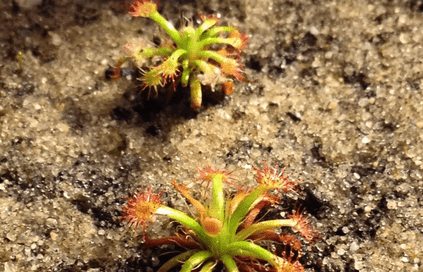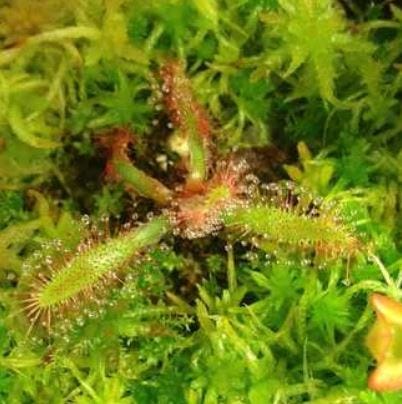GROWING SOUTH AMERICAN DROSERA
Introduction
South Americans are some of the most diverse, beautiful, and (unfortunately) temperamental species in the entire genus. In many respects, they are grown the same way as Heliamphora or Highland Nepenthes, as I will detail below.
Temperature
When cultivating South American sundews, temperature is very important. In general, daytime temperatures below 80°F are optimal, though some growers report that they've had success growing more tolerant species like Drosera graomogolensis in warmer conditions. Temperatures at night should be decently cooler than during the day; I'd recommend temperatures below 65°F but above 50°F. The warmer your temperatures are during the day, the colder you should try to make your temperatures at night.
Lighting
Like nearly all other carnivorous plants, South American Drosera love light. When under enough light, most will color up with a gorgeous pink/red hue. However, if increasing your light levels, make sure to acclimate the plants.
Humidity
All South American species appreciate high humidity. My plants do well with 65% humidity during the day and around 100% humidity at night. As long as humidity levels are above 60%, there shouldn't be a problem with most species. Some growers claim to have acclimated Drosera graomogolensis to windowsill humidity.
Media and Pot Size
These plants have long roots, and as a result should be grown in tall pots; I have had 0.5" D. graomogolensis plants with 5" roots. I use 8" tall pots to allow for ample root growth, but anything over 4 or 5" should be sufficient. As far as media goes, growers have had success with pretty much every type of typical CP media (peat/sand, LFS, living sphagnum, etc.) It's best to pick a media that suits your conditions. What do I mean by this? Living sphagnum typically keeps roots cooler than a peat mix. So, if you have warmer conditions than you like, it would be advantageous to use living sphagnum instead of peat. Experimentation is probably required to find the best media for your conditions.
Feeding and Fertilization
Like all other sundews, feeding South American Drosera will greatly increase their growth. However, be careful not to use large pieces of food, as these often damage and burn leaves. Some CPs are tolerant of being fertilized through their roots, but these plants ARE NOT!
Propagation
Like most Drosera, South Americans usually flower, self-pollinate, and set seed. However, some exceptions do exist, such as D. graomogolensis, D. meristocaulis, and D. ascendens (true ascendens; not latifolia). These species, among some others, flower but require cross-pollination from a genetically different plant to produce seeds. It is unknown whether the common clones in cultivation are self-sterile or if this applies to all members of the species. I've had success with leaf cuttings, though I don't think they'd work for smaller species like D. meristocaulis, D. solaris, and D. roraimae; the same goes for root cuttings.
Final Notes
Like Heliamphora (and pretty much every other highlander), South American Drosera appreciate stable conditions and are very upset by change! So, if you've just recently purchased one and it doesn't look too hot, don't fret. Whenever repotting, I make sure to keep the plant bagged for around one month afterwards; the extra humidity helps it acclimate and recover more quickly. If you're thinking about purchasing your first SA Drosera, an easy species like D. graomogolensis or D. spiralis would be a great place to start. Species like D. meristocaulis and D. villosa are not very forgiving!







